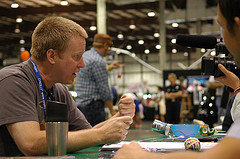
 A lot goes into making sure gathering consumer feedback happens for a project. For field work, getting staff in field with a way to administer the survey quickly and efficiently takes substantial setup. For online research, getting an accurate list to contact is such an important job it’s its own business. But that does not cover the last and most important step in collecting data: getting people to take a survey. But by being prepared and knowing a bit about your target, you can take steps to ensure you hit your targets.
A lot goes into making sure gathering consumer feedback happens for a project. For field work, getting staff in field with a way to administer the survey quickly and efficiently takes substantial setup. For online research, getting an accurate list to contact is such an important job it’s its own business. But that does not cover the last and most important step in collecting data: getting people to take a survey. But by being prepared and knowing a bit about your target, you can take steps to ensure you hit your targets.
Where to place ethnographers at events
Gathering consumer feedback has a number of hurdles that can prevent data collection. The first is location.
If your event marketing program is distributing samples or something similar, it is easy enough to simply ask people before or after sampling if they would like to take the survey.
The difficulty arises when you have a sales-oriented event. In these types of cases, you obviously want to have your ethnographer positioned in such a way that they do not deter people from interacting with sales staff.
Some people will be concerned that if they interact with your event, they will then have to spend time answering all of your questions as well, and this will prevent them from approaching in the first place. Additionally, you want to be sure that you are gathering consumer feedback from those who have fully experienced the event, that way you know what they are feeling as they walk away.
As such, we recommend you staff your ethnographer slightly removed from the event footprint. Have them approach consumers after they have stepped off the event footprint. This will ensure the both of the above points, and give you a reliable way to collect data.
Adressing consumer time constraints
Next you must deal with the length of your survey. If your survey is short (15 questions or less), then things are in your favor.
As a part of your greeting, have each ethnographer mention the length of the survey. In doing so, you ensure that you don’t dissuade people who are afraid they will have to spend the next 10 minutes answering questions.
A simple line such as “the survey is only 10 questions, and should take less than two minutes to complete” can go a long way to getting the average person to participate. If you find your survey does extend much beyond 15 questions, this starts to fall into the range where people may expect some compensation for participating.
Something simple, any type of event related swag will likely help. For the longest surveys (those that would take 7 or more minutes to complete) it is recommended you offer a cash incentive. At this length, most people will drop out or not agree to participate, but a 5 to 10 dollar incentive will convince most people to stick through to the end of the survey.
While this significantly increases the cost of data collection, it will likely be the best way to get consistent and complete results.
This covers the basics of gathering on-site consumer feedback. I will be following up with how to ensure online responses in my next post.
Photo Source: https://www.flickr.com/photos/linecon0/
